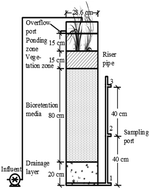Bioretention systems have been found to be effective for the removal of TSS, COD and heavy metals in rainfall runoff. However, in many cases, they fail to remove nitrogen (N) and phosphorus (P). Water treatment residual (WTR), a common by-product of drinking water treatment, has shown high P removal capability. In this work, to enhance P removal in bioretention, WTR (15 wt%) was employed as an amendment in a sandy loam (85 wt%) bioretention column. The pollutant/nutrient (especially N and P) removal efficiencies of the WTR-modified column were evaluated and compared with those of the unmodified control. The results showed that both systems achieved excellent TSS (92–97%) and COD (64–95%) removal. For P removal, however, the unmodified reactor only captured an average of 10–23% total P (TP) after 1-month of operation, while the WTR-modified column achieved a TP removal efficiency of >99%, with the effluent P concentration being ≤0.08 mg L−1. For N, while both reactors were able to remove >90% of NH4+-N, they were much less effective for the removal of TN and NO3−-N, with an average removal of ∼39% and ∼21%, respectively. To enhance N removal, a 40 cm internal water storage zone (IWS) was installed at the bottom of the columns, which increased the retention time and created an anoxic zone for denitrification. As a result, the average TN and NO3−-N removal increased to ∼75% and ∼85%, respectively, with a retention time of 2 h regardless of the WTR. While both reactors achieved remarkable removal of heavy metals or metalloids, which included Cu, Zn, Cd, Pb, and As, the WTR-modified column demonstrated much higher Cr(VI) removal. Overall, this study demonstrated that WTR amendment and IWS modification can substantially enhance the removal efficiencies of multiple contaminants in bioretention systems.
